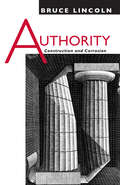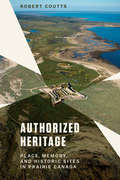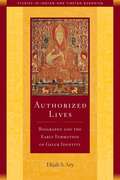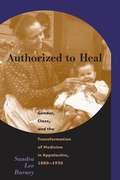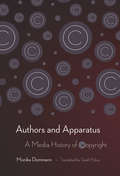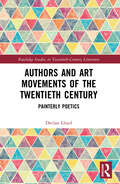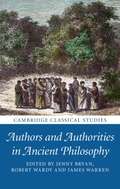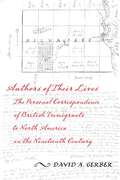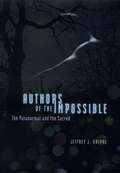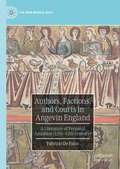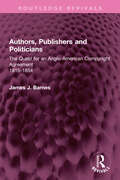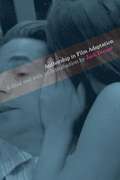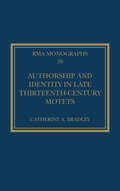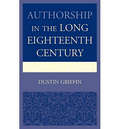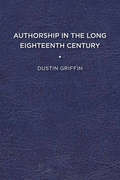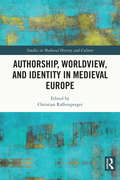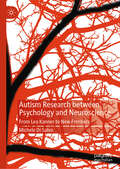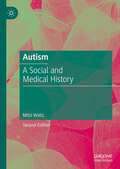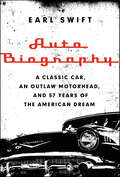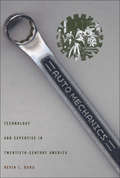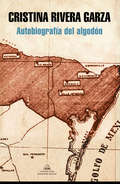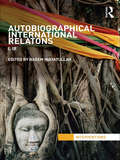- Table View
- List View
Authority: Construction and Corrosion
by Bruce LincolnWhat is authority? How is it constituted? How ought one understand the subtle (and sometimes not-so-subtle) relations between authority and coercion? Between authorized and subversive speech? In this fascinating and intricate analysis, Bruce Lincoln argues that authority is not an entity but an effect. More precisely, it is an effect that depends for its power on the combination of the right speaker, the right speech, the right staging and props, the right time and place, and an audience historically and culturally conditioned to judge what is right in all these instances and to respond with trust, respect, and even reverence. Employing a vast array of examples drawn from classical antiquity, Scandinavian law, Cold War scholarship, and American presidential politics, Lincoln offers a telling analysis of the performance of authority, and subversions of it, from ancient times to the present. Using a small set of case studies that highlight critical moments in the construction of authority, he goes on to offer a general examination of "corrosive" discourses such as gossip, rumor, and curses; the problematic situation of women, who often are barred from the authorizing sphere; the role of religion in the construction of authority; the question of whether authority in the modern and postmodern world differs from its premodern counterpart; and a critique of Hannah Arendt's claims that authority has disappeared from political life in the modern world. He does not find a diminution of authority or a fundamental change in the conditions that produce it. Rather, Lincoln finds modern authority splintered, expanded, and, in fact, multiplied as the mechanisms for its construction become more complex—and more expensive.
Authorized Heritage: Place, Memory, and Historic Sites in Prairie Canada
by Robert Coutts"Authorized Heritage" analyses the history of commemoration at heritage sites across western Canada. Using extensive research from predominantly government records, it argues that heritage narratives are almost always based on national messages that commonly reflect colonial perceptions of the past. Yet many of the places that commemorate Indigenous, fur trade, and settler histories are contested spaces, places such as Batoche, Seven Oaks, and Upper Fort Garry being the most obvious. At these heritage sites, Indigenous views of history confront the conventions of settler colonial pasts and represent the fluid cultural perspectives that should define the shifting ground of heritage space. Robert Coutts brings his many years of experience as a public historian to this detailed examination of heritage sites across the prairies. He shows how the process of commemoration often reflects social and cultural perspectives that privilege a conventional and conservative national narrative. He also examines how class, gender, and sexuality often remain apart from the heritage discourse. Most notably, Authorized Heritage examines how governments became the mediators of what is heritage and, just as significantly, what is not.
Authorized Lives
by Elijah AryUncover the surprising ways the status of Tsongkhapa, one of Tibet's most celebrated saints, evolved over time.Authorized Lives is the first work devoted to early Geluk history and to the role of biographies in shifting established lineages. As the dominant tradition of Tibetan Buddhism that provides the intellectual backdrop for the Dalai Lama's teachings, the Geluk lineage traces its origins to the figure of Tsongkhapa Losang Drakpa (1357-1419). Gelukpas today believe Tsongkhapa is a manifestation of the bodhisattva Manjushri and revere him with his two heart disciples, Gyaltsap and Khedrup. But as Elijah Ary, a former Geluk monk and Harvard-trained scholar, points out, both of these conceptions of Tsongkhapa arose many decades after his death. Delving into the early Geluk biographical tradition, Ary follows the tracks of this evolution in the biographies of Tsongkhapa, Khedrup, and the influential early Geluk writer and reformer Jetsun Chokyi Gyaltsen.
Authorized to Heal
by Sandra Lee BarneyIn this book, Sandra Barney examines the transformation of medical care in Central Appalachia during the Progressive Era and analyzes the influence of women volunteers in promoting the acceptance of professional medicine in the region. By highlighting the critical role played by nurses, clubwomen, ladies' auxiliaries, and other female constituencies in bringing modern medicine to the mountains, she fills a significant gap in gender and regional history.Barney explores both the differences that divided women in the reform effort and the common ground that connected them to one another and to the male physicians who profited from their voluntary activity. Held together at first by a shared goal of improving the public welfare, the coalition between women volunteers and medical professionals began to fracture when the reform agendas of women's groups challenged physicians' sovereignty over the form of health care delivery. By examining the professionalization of male medical practitioners, the gendered nature of the campaign to promote their authority, and their displacement of community healers, especially female midwives, Barney uncovers some of the tensions that evolved within Appalachian society as the region was fundamentally reshaped during the era of industrial development.
Authors and Apparatus: A Media History of Copyright
by Monika DommannCopyright is under siege. From file sharing to vast library scanning projects, new technologies, actors, and attitudes toward intellectual property threaten the value of creative work. However, while digital media and the Internet have made making and sharing perfect copies of original works almost effortless, debates about protecting authors' rights are nothing new. In this sweeping account of the evolution of copyright law since the mid-nineteenth century, Monika Dommann explores how radical media changes—from sheet music and phonographs to photocopiers and networked information systems—have challenged and transformed legal and cultural concept of authors' rights.Dommann provides a critical transatlantic perspective on developments in copyright law and mechanical reproduction of words and music, charting how artists, media companies, and lawmakers in the United States and western Europe approached the complex tangle of technological innovation, intellectual property, and consumer interests. From the seemingly innocuous music box, invented around 1800, to BASF's magnetic tapes and Xerox machines, she demonstrates how copyright has been continuously destabilized by emerging technologies, requiring new legal norms to regulate commercial and private copying practices. Without minimizing digital media's radical disruption to notions of intellectual property, Dommann uncovers the deep historical roots of the conflict between copyright and media—a story that can inform present-day debates over the legal protection of authorship.
Authors and Art Movements of the Twentieth Century: Painterly Poetics (Routledge Studies in Twentieth-Century Literature)
by Declan LloydThis book explores the great influence of twentieth-century artists and art movements on many major writers of the twentieth century. It focuses in particular on four seminal writers who were strongly influenced by very different movements: they are Gertrude Stein and Cubism, William S. Burroughs and Dada, J. G. Ballard and Surrealism, and Douglas Coupland and Pop Art. For these authors the presence and influence of these art movements is not limited to a small cluster of texts, but can be felt much more expansively across their work, infiltrating all manner of multifarious and complex dimensions. These authors are all keen to explore new methods of shifting the signature styles and forms of visual art into the literary world. Alongside these more overt methods of artistic transposition, the authors also often demonstrate a deep philosophical affinity with their chosen movements. This book uproots and examines these kinds of artistic engagements, and also explores the authors’ own personal connections with the world of art. For these are all authors not only interested in visual art, but also intimately connected to the art world. Indeed, some went on to become renowned artists in their own right, while others were closely associated with major historical art figures. Above all however, they are unified by a kindred interest in exploring how the methods and philosophies of art can be transposed into, and even challenge the constraints of traditional forms of literature.
Authors and Authorities in Ancient Philosophy (Cambridge Classical Studies)
by James Warren Jenny Bryan Robert WardyAncient Greek and Roman philosophy is often characterised in terms of competitive individuals debating orally with one another in public arenas. But it also developed over its long history a sense in which philosophers might acknowledge some other particular philosopher or group of philosophers as an authority and offer to that authority explicit intellectual allegiance. This is most obvious in the development after the classical period of the philosophical 'schools' with agreed founders and, most importantly, canonical founding texts. There also developed a tradition of commentary, interpretation, and discussion of texts which itself became a mode of philosophical debate. As time went on, the weight of a growing tradition of reading and appealing to a certain corpus of foundational texts began to shape how later antiquity viewed its philosophical past and also how philosophical debate and inquiry was conducted. In this book leading scholars explore aspects of these important developments.
Authors in Court: Scenes from the Theater of Copyright
by Mark RoseMark Rose uses case studies to show how gender and gentility have influenced the self-presentation of authors in court and how the personal styles, public personas, and histories of novelists, dramatists, poets, photographers, and cartoonists have influenced the development of legal doctrine around issues of copyright.
Authors of Their Lives: The Personal Correspondence of British Immigrants to North America in the Nineteenth Century
by David A. Gerber2008 United States Postal System’s Rita Lloyd Moroney AwardIn the era before airplanes and e-mail, how did immigrants keep in touch with loved ones in their homelands, as well as preserve links with pasts that were rooted in places from which they voluntarily left? Regardless of literacy level, they wrote letters, explains David A. Gerber in this path-breaking study of British immigrants to the U.S. and Canada who wrote and received letters during the nineteenth century.Scholars have long used immigrant letters as a lens to examine the experiences of immigrant groups and the communities they build in their new homelands. Yet immigrants as individual letter writers have not received significant attention; rather, their letters are often used to add color to narratives informed by other types of sources.Authors of Their Lives analyzes the cycle of correspondence between immigrants and their homelands, paying particular attention to the role played by letters in reformulating relationships made vulnerable by separation. Letters provided sources of continuity in lives disrupted by movement across vast spaces that disrupted personal identities, which depend on continuity between past and present. Gerber reveals how ordinary artisans, farmers, factory workers, and housewives engaged in correspondence that lasted for years and addressed subjects of the most profound emotional and practical significance.
Authors of the Impossible: The Paranormal and the Sacred
by Jeffrey J. Kripal&“Outstanding and almost certainly controversial. . . . [Kripal] has promise to revitalize and extend the reach of religious studies.&” —Choice Most scholars dismiss research into the paranormal as pseudoscience, a frivolous pursuit for the paranoid or gullible. Even historians of religion, whose work naturally attends to events beyond the realm of empirical science, have shown scant interest in the subject. But the history of psychical phenomena, Jeffrey J. Kripal contends, is an untapped source of insight into the sacred and by tracing that history through the last two centuries of Western thought we can see its potential centrality to the critical study of religion. Kripal grounds his study in the work of four major figures in the history of paranormal research: psychical researcher Frederic Myers; writer and humorist Charles Fort; astronomer, computer scientist, and ufologist Jacques Vallee; and philosopher and sociologist Bertrand Méheust. Through incisive analyses of these thinkers, Kripal ushers the reader into a beguiling world somewhere between fact, fiction, and fraud. The cultural history of telepathy, teleportation, and UFOs; a ghostly love story; the occult dimensions of science fiction; cold war psychic espionage; galactic colonialism; and the intimate relationship between consciousness and culture all come together in Authors of the Impossible, a dazzling and profound look at how the paranormal bridges the sacred and the scientific. &“An excellent book. . . . engaging, witty, and thoughtful.&” -- Christopher Partridge, Lancaster University &“[Kripal] demands nothing short of a paradigm shift in order to make sense of the odd, the anomalous, and the inexplicable.&” —Catherine L. Albanese, University of California, Santa Barbara &“Quietly earth-shattering.&” — Victoria Nelson, author of The Secret Life of Puppets
Authors, Audiences, and Old English Verse
by Thomas A. BredehoftAuthors, Audiences, and Old English Verse re-examines the Anglo-Saxon poetic tradition from the eighth to the eleventh centuries and reconsiders the significance of formulaic parallels and the nature of poetic authorship in Old English.Offering a new vision of much of Old English literary history, Thomas A. Bredehoft traces a tradition of 'literate-formulaic' composition in the period and contends that many phrases conventionally considered oral formulas are in fact borrowings or quotations. His identification of previously unrecognized Old English poems and his innovative arguments about the dates, places of composition, influences, and even possible authors for a variety of tenth- and eleventh-century poems illustrate that the failure of scholars to recognize the late Old English verse tradition has seriously hampered our literary understanding of the period. Provocative and bold, Authors, Audiences and Old English Verse has the potential to transform modern understandings of the classical Old English poetic tradition.
Authors, Factions, and Courts in Angevin England: A Literature of Personal Ambition (12th–13th Century) (The New Middle Ages)
by Fabrizio De FalcoAuthors, Factions, and Courts in Angevin England: A Literature of Personal Ambition (12th-13th Century) advances a model for historical study of courtly literature by foregrounding the personal aims, networks, and careers as the impetus for much of the period’s literature. The book takes two authors as case studies – Gerald of Wales and Walter Map – to show how authors not only built their own stories but also used popular narratives and the tools of propaganda to achieve their own, personal goals. The purpose of this study is to overturn the top-down model of political patronage, in which patrons – and particularly royal patrons – set the cultural agenda and dictate literary tastes. Rather, Fabrizio De Falco argues that authors were often representative of many different interests expressed by local groups. To pursue those interests, they targeted specific political factions in the changeable political scenario of Angevin England. Their texts reveal a polycentric view of cultural production and its reception. The study aims to model a heuristic process which is applicable to other courtly texts besides the chosen case-studies.
Authors, Publishers and Politicians: The Quest for an Anglo-American Copyright Agreement, 1815-1854 (Routledge Revivals)
by James J. BarnesFirst published in 1974, Authors, Publishers and Politicians describes the efforts to secure an Anglo-American copyright agreement. It explores the underlying causes of the failure of this quest, a failure which enabled literary pirates on both sides of the Atlantic to continue operations for another forty years. It traces the effects this had on the writers and producers of books as well as their reading public. Few aspects of Anglo-American relations were untouched by the drama presented in this study. Its broader implications range from straightforward business transactions, official diplomatic manoeuvres, endless legal complexities, and clandestine political intrigue to the peculiarities involved in book smuggling, newspaper rivalries and industrial espionage. The book will be of interest to students of legal history, publishing and literature.
Authorship In Film Adaptation
by Jack BoozerAuthoring a film adaptation of a literary source not only requires a media conversion but also a transformation as a result of the differing dramatic demands of cinema. The most critical central step in this transformation of a literary source to the screen is the writing of the screenplay. The screenplay usually serves to recruit producers, director, and actors; to attract capital investment; and to give focus to the conception and production of the film project. Often undergoing multiple revisions prior to production, the screenplay represents the crucial decisions of writer and director that will determine how and to what end the film will imitate or depart from its original source. Authorship in Film Adaptation is an accessible, provocative text that opens up new areas of discussion on the central process of adaptation surrounding the screenplay and screenwriter-director collaboration. In contrast to narrow binary comparisons of literary source text and film, the twelve essays in this collection also give attention to the underappreciated role of the screenplay and film pre-production that can signal the primary intention for a film. Divided into four parts, this collection looks first at the role of Hollywood's activist producers and major auteurs such as Hitchcock and Kubrick as they worked with screenwriters to formulate their audio-visual goals. The second part offers case studies of Devil in a Blue Dress and The Sweet Hereafter, for which the directors wrote their own adapted screenplays. Considering the variety of writer-director working relationships that are possible, Part III focuses on adaptations that alter genre, time, and place, and Part IV investigates adaptations that alter stories of romance, sexuality, and ethnicity.
Authorship and Identity in Late Thirteenth-Century Motets (Royal Musical Association Monographs)
by Catherine A. BradleyQuestions of authorship are central to the late thirteenth-century motet repertoire represented by the seventh section or fascicle of the Montpellier Codex (Montpellier, Bibliothèque interuniversitaire, Section de médecine, H. 196, hereafter Mo). Mo does not explicitly attribute any of its compositions, but theoretical sources name Petrus de Cruce as the composer of the two motets that open fascicle 7, and three later motets in this fascicle are elsewhere ascribed to Adam de la Halle. This monograph reveals a musical and textual quotation of Adam’s Aucun se sont loe incipit at the outset of Petrus’s Aucun ont trouve triplum, and it explores various invocations of Adam and Petrus – their works and techniques – within further anonymous compositions. Authorship is additionally considered from the perspective of two new types of motets especially prevalent in fascicle 7: motets that name musicians, as well as those based on vernacular song or instrumental melodies, some of which are identified by the names of their creators. This book offers new insights into the musical, poetic, and curatorial reception of thirteenth-century composers’ works in their own time. It uncovers, beneath the surface of an anonymous motet book, unsuspected interactions between authors and traces of compositional identities.
Authorship in the Long Eighteenth Century
by Dustin GriffinThis book deals with changing conditions and conceptions of authorship in the long eighteenth century, a period often said to have witnessed the birth of the modern author. It focuses not on authorial self-presentation or self-revelation but on an author’s interactions with booksellers, collaborators, rivals, correspondents, patrons, and audiences. Challenging older accounts of the development of authorship in the period as well as newer claims about the “public sphere” and the “professional writer,” it engages with recent work on print culture and the history of the book. Methodologically eclectic, it moves from close readings to strategic contextualization. The book is organized both chronologically and topically. Early chapters deal with writers – notably Milton and Dryden – at the beginning of the long eighteenth century, and later chapters focus more on writers — among them Johnson, Gray, and Gibbon — toward its end. Looking beyond the traditional canon, it considers a number of little-known or little-studied writers, including Richard Bentley, Thomas Birch, William Oldys, James Ralph, and Thomas Ruddiman. Some of the essays are organized around a single writer, but most deal with a broad topic – literary collaboration, literary careers, the republic of letters, the alleged rise of the “professional writer,” and the rather different figure of the “author by profession.” Published by University of Delaware Press. Distributed worldwide by Rutgers University Press.
Authorship in the Long Eighteenth Century
by Dustin GriffinThis book deals with changing conditions and conceptions of authorship in the long eighteenth century, a period often said to have witnessed the birth of the modern author. It focuses not on authorial self-presentation or self-revelation but on an author’s interactions with booksellers, collaborators, rivals, correspondents, patrons, and audiences. Challenging older accounts of the development of authorship in the period as well as newer claims about the “public sphere” and the “professional writer,” it engages with recent work on print culture and the history of the book. Methodologically eclectic, it moves from close readings to strategic contextualization. The book is organized both chronologically and topically. Early chapters deal with writers – notably Milton and Dryden – at the beginning of the long eighteenth century, and later chapters focus more on writers — among them Johnson, Gray, and Gibbon — toward its end. Looking beyond the traditional canon, it considers a number of little-known or little-studied writers, including Richard Bentley, Thomas Birch, William Oldys, James Ralph, and Thomas Ruddiman. Some of the essays are organized around a single writer, but most deal with a broad topic – literary collaboration, literary careers, the republic of letters, the alleged rise of the “professional writer,” and the rather different figure of the “author by profession.” Published by University of Delaware Press. Distributed worldwide by Rutgers University Press.
Authorship, Worldview, and Identity in Medieval Europe (Studies in Medieval History and Culture)
by Christian RaffenspergerWhat did medieval authors know about their world? Were they parochial and focused on just their monastery, town, or kingdom? Or were they aware of the broader medieval Europe that modern historians write about? This collection of essays brings the focus back to medieval authors to see how they described their world. While we see that each author certainly had their own biases, the vast majority of them did not view the world as constrained to their small piece of it. Instead, they talked about the wider world and often they had informants or textual sources that informed them about the world, even if they did not visit it themselves. This volume shows that they also used similar ideas to create space and identity – whether talking about the desert, the holy land, or food practices in their texts. By examining medieval authors and their own perception of their world, this collection of essays offers a framework for discussions of medieval Europe in the twenty-first century.
Autism Research between Psychology and Neuroscience: From Leo Kanner to New Frontiers
by Michele Di SalvoThis book offers an overview of the history, definitions, and treatments for autism spectrum disorders from 1943 to the present day. Bridging the gap between psychology and neuroscience through a rigorous reconstruction of eighty years of research, the author retraces the emergence of the definition of autism and the description of its characteristics, the history of the diagnosis and standardized classification of ASD in the Diagnostic and Statistical Manual of Mental Disorders, and the development of etiological research and therapeutic interventions in medical, psychoeducational, and alternative therapies. The content spans neurology, genetics, psychiatry, and medicine, integrating discoveries from different fields to shed light on relevant factors of the pathology and dynamics of ASD. A useful resource for students and researchers in psychology, psychiatry, special education, and healthcare, this book unveils the latest advances in the field of ASD and discusses the research agenda for the years to come, showcasing multidirectional approaches to improve the quality of life of autistic people.
Autism: A Social and Medical History
by Mitzi WaltzThis expanded second edition of Mitzi Waltz’s Autism: A Social and Medical History offers an in-depth examination of how the condition was perceived before it became a separate area of investigation, and how autism has been conceptualised and treated since. As well as strengthening the existing text, Waltz has added material on a number of topics that have received increased attention since the first edition, including the rise of the anti-vaccination movement, the shift towards genetic and genomic research, and the progress of the autism self-advocacy movement. The author examines these issues through the perspective of what they mean for autistic people, clinicians and society, and looks at the challenges still faced by autistic people. Waltz also looks at the increased autism diagnosis among girls and women, and how autism has been represented in traditional media and social media. The book includes information from interviews with key researchers, parents of autistic children and people with autism.
Auto Biography: A Classic Car, an Outlaw Motorhead, and 57 Years of the American Dream
by Earl SwiftA brilliant blend of Shop Class as Soulcraft and The Orchid Thief, Earl Swift's wise, funny, and captivating Auto Biography follows an outlaw auto dealer as he struggles to save a rusted '57 Chevy—a car that has already passed through twelve pairs of hands before his—while financial ruin, government bureaucrats and the FBI close in on him.Slumped among hundreds of other decrepit hulks on a treeless, windswept moor in eastern North Carolina, the Chevy evokes none of the Jet Age mystique that made it the most beloved car to ever roll off an assembly line. It's open to the rain. Birds nest in its seats. Officials of the surrounding county consider it junk.To Tommy Arney, it's anything but: It's a fossil of the twentieth-century American experience, of a place and a people utterly devoted to the automobile and changed by it in myriad ways. It's a piece of history—especially so because its flaking skin conceals a rare asset: a complete provenance, stretching back more than fifty years.So, hassled by a growing assortment of challengers, the Chevy's thirteenth owner—an orphan, grade-school dropout and rounder, a felon arrested seventy-odd times, and a man who's been written off as a ruin himself--embarks on a mission to save the car and preserve long record of human experience it carries in its steel and upholstery.Written for both gearheads and Sunday drivers, Auto Biography charts the shifting nature of the American Dream and our strange and abiding relationship with the automobile, through an iconic classic and an improbable, unforgettable hero.
Auto Mechanics: Technology and Expertise in Twentieth-Century America (Studies in Industry and Society)
by Kevin L. BorgThe history of automobiles is not just the story of invention, manufacturing, and marketing; it is also a story of repair. Auto Mechanics opens the repair shop to historical study—for the first time—by tracing the emergence of a dirty, difficult, and important profession.Kevin L. Borg's study spans a century of automotive technology—from the horseless carriage of the late nineteenth century to the "check engine" light of the late twentieth. Drawing from a diverse body of source material, Borg explores how the mechanic’s occupation formed and evolved within the context of broad American fault lines of class, race, and gender and how vocational education entwined these tensions around the mechanic’s unique expertise. He further shows how aspects of the consumer rights and environmental movements, as well as the design of automotive electronics, reflected and challenged the social identity and expertise of the mechanic.In the history of the American auto mechanic, Borg finds the origins of a persistent anxiety that even today accompanies the prospect of taking one's car in for repair.
Auto Pact
by Dimitry AnastakisThe 1965 Canada-United States Automotive Trade agreement fundamentally reshaped relations between the automotive business and the state in both countries and represented a significant step toward the creation of an integrated North American economy. Breaking from previous conceptions of the agreement as solely a product of intergovernmental negotiation, Dimitry Anastakis's Auto Pact argues that the 'big three' auto companies played a pivotal role - and benefited immensely - in the creation and implementation of this new automotive regime. With the border effectively erased by the agreement, the pact transformed these giant enterprises into truly global corporations.Drawing from newly released archival sources, Anastakis demonstrates that, for Canada's automotive policy makers, continentalism was a form of economic nationalism. Although the deal represented the end of any notion of an indigenous Canadian automotive industry, significant economic gains were achieved for Canadians under the agreement. Anastakis provides a fresh and alternative view of the auto pact that places it firmly within contemporary debates about the nature of free trade as well as North American - and, indeed, global - integration. Far from being a mere artefact of history, the deal was a forebearer to what is now known as 'globalization.'
Autobiografía del algodón
by Cristina Rivera Garza"Autobiografía del algodónAutobiografía algodón dota de un nuevo y extraordinario significante al territorio de la frontera norte de México, que aquí se erige majestuoso sobre el movimiento nómada y las rutas de recuerdos." Yásnaya Elena Aguilar Indagar sobre el origen personal es abrir la puerta a muchas preguntas, a silencios y respuestas impensadas que a veces terminan por ser un revés de la memoria. En Autobiografía del algodón, Cristina Rivera Garza sigue con curiosidad y asombro los pasos de aquellos hombres y mujeres que habitan su pasado familiar, obreros y campesinos que trabajaron la tierra que ahora conforma la frontera entre Tamaulipas y Texas, una región que alcanzó un alto nivel económico, social y cultural gracias al sistema de siembra del algodón. Es así que esta novela es, además de íntima, un reencuentro con el territorio. O un desencuentro, debido a la migración, deportación, expulsión y repatriación de aquellos campesinos algodoneros que, tras el fracaso del sistema, dejaron libre su espacio, antes símbolo de progreso, hoy ocupado por la llamada guerra contra el narco.
Autobiographical International Relations: I, IR (Interventions)
by Naeem InayatullahThis volume provides a novel approach to international relations. In the course of fifteen essays, scholars write about how life events brought them to their subject matter. They place their narratives in the larger context of world politics, culture, and history. Autobiographical International Relations believes that the fictive distancing associated with academic prose creates disaffection in both readers and writers. In contrast, these essays demonstrate how to reengage the "I" while simultaneously sustaining theoretical precision and historical awareness. Authors highlight their motives, their desires, and their wounds. By connecting their theoretical and practical engagements with their needs and wounds, and by working within the overlap between theory, history, and autobiography, these essays aim to increase the clarity, urgency, and meaningfulness of academic work. These essays are autobiographical, but focused on the academic aspect of authors’ lives. Specifically, they are set within the domain of international relations/global politics. They are theoretical, but geared to demonstrate that theoretical decisions emerge from theorists’ needs and wounds. Theoretical precision, rather than being explicitly deduced, is instead immanent to the autobiographical and the historical/cultural narrative each author portrays. And, these essays are framed in historical/cultural terms, but seek to bind together theory, history, culture, and the personal into a differentiated and vibrant whole. This book moves the field of International Relations towards greater candidness about how personal narrative influences theoretical articulations. No such volume currently exists in the field of international relations.
